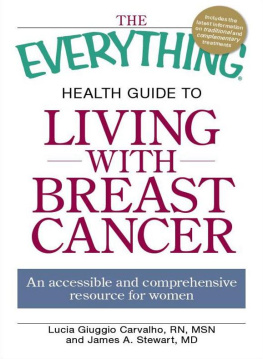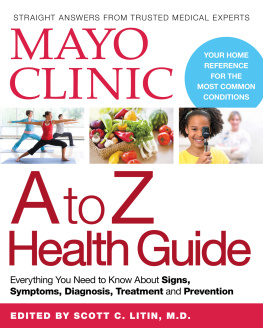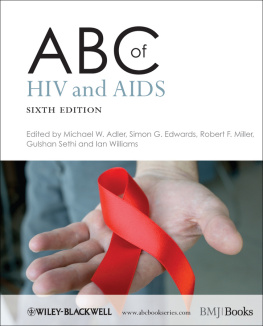A Womans Guide
to Living with
HIV Infection
SECOND EDITION
Rebecca A. Clark, M.D., Ph.D.
Robert T. Maupin, Jr., M.D., FACOG
and Jill Hayes, Ph.D.

2004, 2012 The Johns Hopkins University Press
All rights reserved. Published 2004, 2012
Printed in the United States of America on acid-free paper
9 8 7 6 5 4 3 2 1
The Johns Hopkins University Press
2715 North Charles Street
Baltimore, Maryland 21218-4363
www.press.jhu.edu
Library of Congress Cataloging-in-Publication Data
Clark, Rebecca A., 1958
A womans guide to living with HIV infection / Rebecca A. Clark, Robert T. Maupin, and Jill Hayes. 2nd ed.
p. cm. (A Johns Hopkins Press health book)
Includes bibliographical references and index.
ISBN-13: 978-1-4214-0548-3 (hdbk. : alk. paper)
ISBN-13: 978-1-4214-0549-0 (pbk. : alk. paper)
ISBN-13: 978-1-4214-0592-6 (electronic)
ISBN-10: 1-4214-0548-2 (hdbk. : alk. paper)
ISBN-10: 1-4214-0549-0 (pbk. : alk. paper)
ISBN-10: 1-4214-0592-X (electronic)
1. AIDS (Disease) in womenPopular works. 2. HIV-positive womenMedical carePopular works. I. Maupin, Robert T., 1963 II. Hammer, Jill Hayes, 1968
III. Title.
RC606.64.C53 2012
362.19697920082dc23 2011036256
A catalog record for this book is available from the British Library.
The authors acknowledge and appreciate thoughtful reviews of selected chapters by Mary Murphy, M.D. ().
Special discounts are available for bulk purchases of this book. For more information, please contact Special Sales at 410-516-6936 or specialsales@press.jhu.edu.
The Johns Hopkins University Press uses environmentally friendly book materials, including recycled text paper that is composed of at least 30 percent post-consumer waste, whenever possible.
The facing page is a continuation of this copyright page.
Note to the reader: This book is not meant to substitute for medical care. Treatment plans for people with HIV infection must be developed in a dialogue between an individual and her primary care provider. Our book is intended to help with that dialogue.
Drug dosage: The author and publisher have made reasonable efforts to determine that the selection and dosage of drugs discussed in this text conform to the actual practices of the general medical community. However, the medications described do not necessarily have specific approval by the U.S. Food and Drug Administration for use in the diseases and dosages for which they are recommended here. In view of ongoing research, changes in governmental regulations, and the constant flow of information relating to drug therapy and drug reactions, the reader is urged to check the package insert of each drug for any change in indications and dosage and for warnings and precautions. This is particularly important when the recommended agent is a new and/or infrequently used drug.
To women living with HIV, in recognition
of their courage and the challenges
many of them overcome to obtain care
for themselves and their children
Contents
A Womans Guide
to Living with HIV Infection
Introduction:
Women and the HIV/AIDS Epidemic
Key Questions
1. What is the Human Immunodeficiency Virus?
2. What is the history of the HIV/AIDS epidemic?
3. What is the best way to read this book?
First, some comforting facts:
You are not alone. Every year, thousands of women in the United States are diagnosed with HIV.
HIV infections have been reported in every area in the United States, even in very small towns in the countryside.
Anyone who has ever had sex could have become infected with HIV. This includes the vast majority of adults. You need not feel embarrassed that you are infected.
Current HIV treatments are extremely powerful. If you have not been sick from your HIV infection, there is a good chance that you may never get sick. If you are sick, it is likely that you can get better, particularly if you are starting HIV treatments for the first time.
We have written this guide to help you understand HIV and to help you find support and treatment for yourself or for the woman with HIV in your life. HIV stands for human immunodeficiency virus. It differs from other viruses like cold viruses because, unlike most other viral infections, HIV damages peoples immune systemsthe complex defense network that our bodies rely on to protect us from infections of all kinds. People infected with HIV who do not receive treatment eventually lose their natural ability to defend themselves from infections. AIDS (which stands for Acquired Immune Deficiency Syndrome) means that the immune system of someone who is infected with HIV has lost the ability to prevent medical conditions that other people rarely experience. Today, thanks to new medications that hold HIV in check, AIDS is an avoidable and treatable condition. One of the goals of this book is to explain the power of these highly effective medications.
The HIV/AIDS epidemic currently affects hundreds of thousands of women in the United States and around the world. Approximately 50 percent of adults living with HIV or AIDS worldwide are women. At the beginning of the epidemic, men were thought to be at higher risk than women for developing AIDS, but AIDS is now recognized as a growing problem among women. The Centers for Disease Control and Prevention (CDC), an agency in the U.S. Department of Health and Human Services, has monitored the number of cases of AIDS in the United States since 1986 when the epidemic first appeared among gay men. Soon after, people who used injectable street drugs or who received blood products were also found to be at risk for HIV infection.
Initially, less than 5 percent of the AIDS cases recorded by the CDC were women. This low number suggests either that HIV infection was uncommon among women at the beginning or that health care providers were simply not recognizing AIDS in women with symptoms. Since the mid-1980s, however, more and more women have developed unmistakable AIDS. In the year 2007, 27 percent of the recorded new AIDS cases were in women, and the CDC estimates that 30 percent of the approximately 40,000 new HIV infections that occur each year in the United States are in women. In 2008, nearly 10,000 new cases of AIDS were diagnosed in women.
HIV has disproportionately affected women of color. The rate of new HIV infection for black/African-American women is nearly fifteen times that of white women, and the rate of new HIV infection among Hispanic/Latina women is nearly four times that of white women.
Most women with HIV were infected by having sex with men. Although approximately 2 percent of the women diagnosed with AIDS have identified themselves as having sex with women, nearly all of them had other risk factors for HIV, so it is likely that they acquired HIV, not by having sex with other women, but by some other means. Clearly, for women, sex with menheterosexual sexis the number-one risk factor for acquiring HIV. The second major risk factor is using injectable street drugs.
We wrote this book for women personally affected by HIV/AIDS as well as for their families and friends. Other books that provide medical information about HIV do not comprehensively cover topics of special interest to women, and most books on womens health do not discuss women with HIV. Yet women with HIV have unique concerns regarding gynecologic disorders, reproductive choices, contraception, and pregnancy. We believe this book will help many women to lead better-informed and, we hope, healthier lives.







